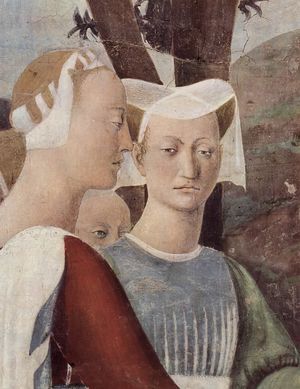Art and magic
One of my favorite paintings in the world is Piero della Francesca's "Madonna del Parto," so I smiled to read this in "Heaven on Earth," Peter Schjeldahl's review of the current Piero della Francesca show at the Frick in New York:
"One hot August, when I was twenty-three," he writes, "I traversed Tuscany on the back
of a Vespa driven by a painter friend, George Schneeman. We had seen
Piero’s magnum opus, the 'Legend of the True Cross' frescoes, in Arezzo,
which I found bewildering, and were headed northeast, to the artist’s
home town of Sansepolcro, the site of his famous 'Resurrection of
Christ' ('the best picture in the world,' according to Aldous Huxley),
which I also failed to make much of. Then we stopped at a tiny cemetery
chapel, in the hill town of Monterchi, to see Piero’s highly unusual 'Madonna del Parto.' An immensely pregnant but delicately elegant young
Mary stands pensively in a bell-shaped tent, as two mirror-image angels
sweep aside the flaps to reveal her. One angel wears green, the other
purple. Here was the circumstantial drama of a ripeness with life in a
place of death. George told me a sentimental, almost certainly untrue
story that the work memorialized a secret mistress of Piero’s who had
died in childbirth. This befitted the picture’s held-breath tenderness
and its air of sharing a deeply felt, urgent mystery. In another age,
the experience might have made me consider entering a monastery.
Instead, I became an art critic."
 Some years ago I made the same pilgrimage to Arrezo, Sansepolcro, and the Tuscan hilltown of Monterchi -- but unlike Schjeldahl, I was already under Piero's spell when I did so. Although what I really wanted was to see the Madonna del Parto freshly painted on the wall of the Chapel of Santa Maria di Momentana (which would have required travelling back in time to the 15th century), it was a deeply moving experience nonetheless to stand before the Lady at last, even in her rather sterile new home in the small Museo della Madonna.
Some years ago I made the same pilgrimage to Arrezo, Sansepolcro, and the Tuscan hilltown of Monterchi -- but unlike Schjeldahl, I was already under Piero's spell when I did so. Although what I really wanted was to see the Madonna del Parto freshly painted on the wall of the Chapel of Santa Maria di Momentana (which would have required travelling back in time to the 15th century), it was a deeply moving experience nonetheless to stand before the Lady at last, even in her rather sterile new home in the small Museo della Madonna.
A print that I purchased that day in Monterchi hangs framed beside my drawing board still, where I draw and paint underneath the Lady's calm, enigmatic gaze. I am not Christian, so for me Piero's luminous figure represents the feminine and maternal mysteries, and the fecund spirit of creativity. This is not, of course, what the painter intended...but works of art, if they have any power, take on lives of their own once they leave our hands.
As Samuel R. Delany once wrote (in his ground-breaking novel Dahlgren): "The artist has some internal experience that produces a poem, a
painting, a piece of music. Spectators submit themselves to the work,
which generates an inner experience for them. But historically it's a
very new, not to mention vulgar, idea that the spectator's experience
should be identical to, or even have anything to do with, the
artist's. That idea comes from an over-industrialized society which
has learned to distrust magic."
Indeed. But I do trust magic. Especially the magic of art.
 Art above: The Madonna del Parto in Monterchi, a detail from the Legend of the True Cross fresco cycle in Arezzo, and a detail from the Piero's unfinished Nativity, which is now in the National Gallery in London. Photographs: Monterchi, The Lady of the Studio, and the other lady of the studio.
Art above: The Madonna del Parto in Monterchi, a detail from the Legend of the True Cross fresco cycle in Arezzo, and a detail from the Piero's unfinished Nativity, which is now in the National Gallery in London. Photographs: Monterchi, The Lady of the Studio, and the other lady of the studio.
Terri Windling's Blog
- Terri Windling's profile
- 712 followers







